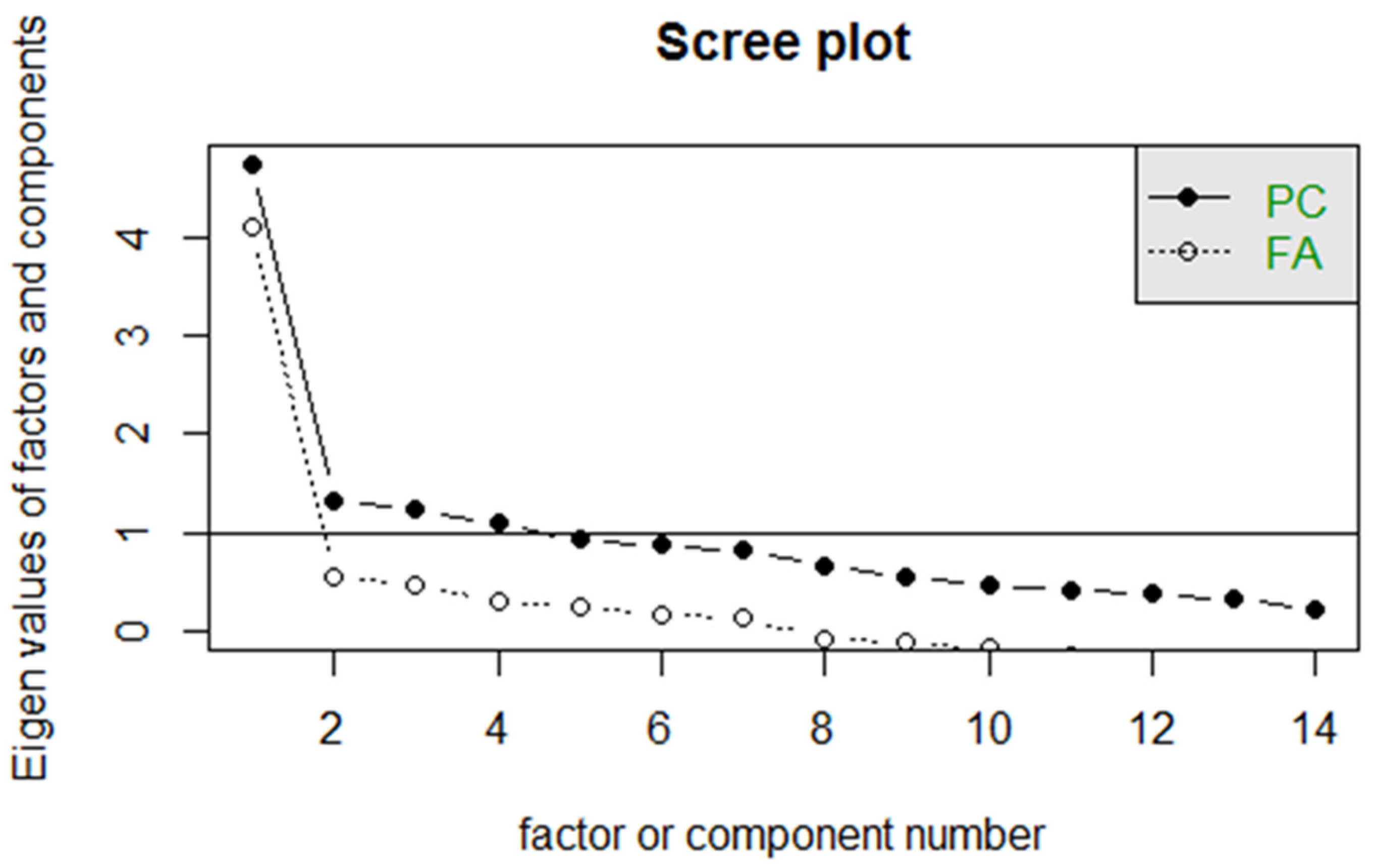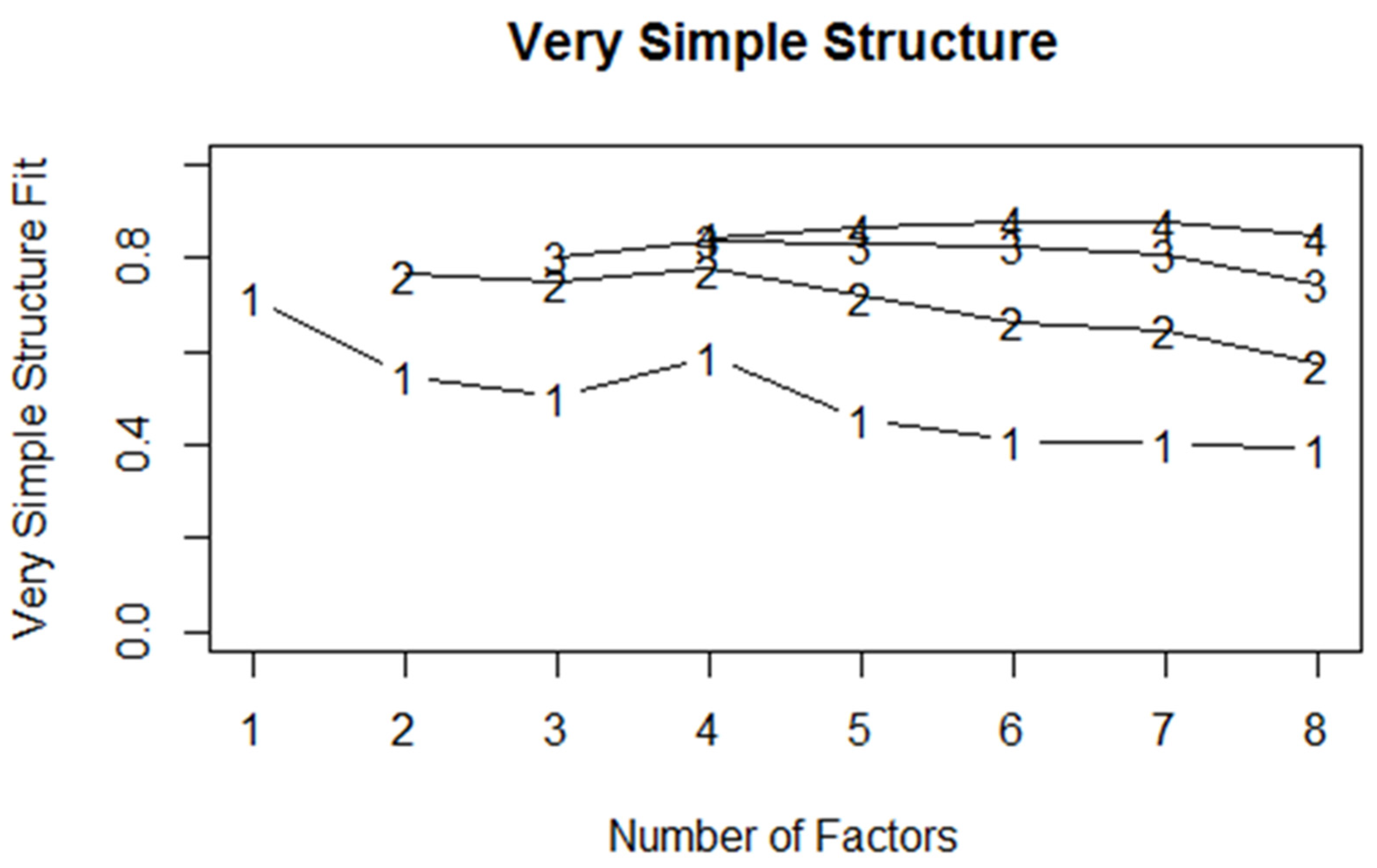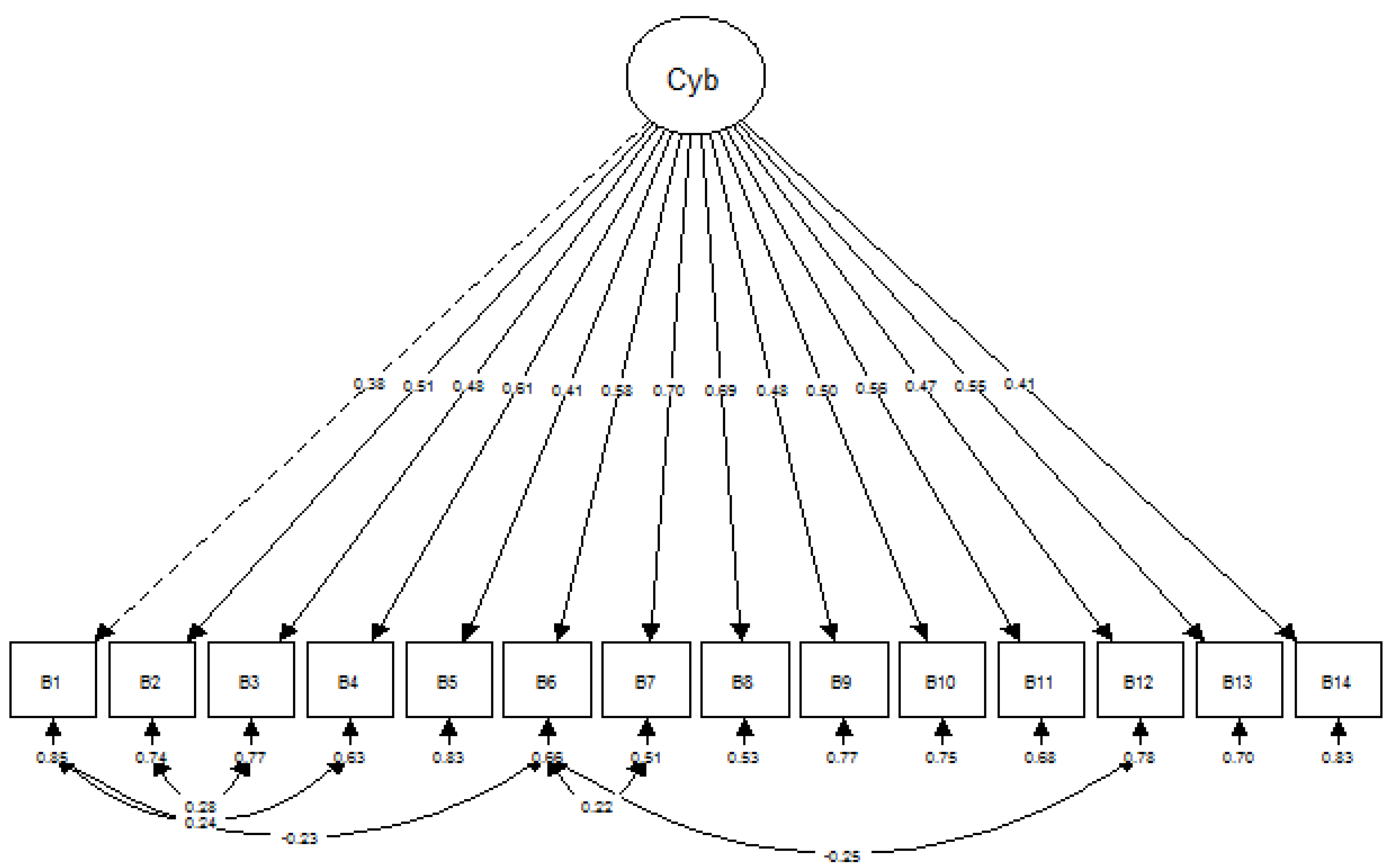The Validity and Reliability of the Malay Version of the Cyberbullying Scale among Secondary School Adolescents in Malaysia
Abstract
:1. Introduction
2. Materials and Methods
2.1. Study Design, Participants
2.2. Instruments
2.3. Questionnaire Translation
2.4. Procedure
2.5. Data Analysis
3. Results
3.1. Participants
3.2. EFA and Internal Consistency
3.3. CFA and Composite Reliability
3.4. Correlation between Cyberbullying and DASS-21’s Factors
4. Discussion
5. Conclusions
Supplementary Materials
Author Contributions
Funding
Institutional Review Board Statement
Informed Consent Statement
Data Availability Statement
Acknowledgments
Conflicts of Interest
References
- Clement, P.J. Global Number of Internet Users 2005–2019. 2020. Available online: https://www.statista.com/topics/1145/internet-usage-worldwide/ (accessed on 27 May 2020).
- Internet World Stats. World Internet Usage and Population Statistics. Available online: https://www.internetworldstats.com/stats.htm (accessed on 27 May 2020).
- Malaysian Communications and Multimedia Comission. Internet Users Survey 2018. Available online: https://www.mcmc.gov.my/skmmgovmy/media/General/pdf/Internet-Users-Survey-2018.pdf (accessed on 27 May 2020).
- Mohd Isa, S.; Ah, H.; Kaur, M.; Cg, N. Internet addiction among adolescents in Malaysia: The prevalence and its association with attention deficit hyperactivity disorder (ADHD) symptoms. Malays. J. Psychiatry 2016, 25, 3–18. [Google Scholar]
- Kapahi, A.; Ling, C.S.; Ramadass, S.; Abdullah, N. Internet addiction in Malaysia Causes and Effects. IBusiness 2013, 5, 72–76. [Google Scholar] [CrossRef] [Green Version]
- Kristy Elity, S.; Tan, C.K. Internet Addiction and Cyber Ethic Issues Among Students from Secondary School in Malaysia. In Proceedings of the ISER 106 International Conference, Malacca, Malaysia, 5–6 February 2018. [Google Scholar]
- Livingstone, S.; Davidson, J.; Bryce, J. Children’ s Online Activities, Risks and Safety A Literature Review by the UKCCIS Evidence Group. 2017. Available online: https://assets.publishing.service.gov.uk/government/uploads/system/uploads/attachment_data/file/759005/Literature_Review_Final_October_2017.pdf (accessed on 10 October 2021).
- Masrom, M.; Hasnaa, N.; Mahmood, N.; Zainon, O. Cyberethics and internet behaviour of Malaysian primary education students. J. Emerg. Trends Educ. Res. Policy Stud. (JETERAPS) 2013, 4, 105–111. [Google Scholar]
- Balakrishnan, V. Cyberbullying among young adults in Malaysia: The roles of gender, age and Internet frequency. Comput. Hum. Behav. 2015, 46, 149–157. [Google Scholar] [CrossRef]
- Institute for Youth Research Malaysia. Buli siber dalam kalangan belia Malaysia [Cyberbullying among Adolescents in Malaysia]. 2017. Available online: http://150.242.181.175/jdownloads/Infografik%20penyelidikan/Buli%20Siber%20Dalam%20Kalangan%20Belia%20Malaysia.pdf (accessed on 16 September 2021). [CrossRef]
- Smith, P.K.; Mahdavi, J.; Carvalho, M.; Fisher, S.; Russell, S.; Tippett, N. Cyberbullying: Its nature and impact in secondary school pupils. J. Child Psychol. Psychiatry 2008, 49, 376–385. [Google Scholar] [CrossRef]
- Hasebrink, U.; Görzig, A.; Haddon, L.; Kalmus, V.; Livingstone, S. Patterns of Risk and Safety Online: In-Depth Analyses from the EU Kids Online Survey of 9- to 16-Year-Olds and Their Parents in 25 European Countries; EU Kids Online Network: London, UK, 2011; Available online: http://eprints.lse.ac.uk/39356/ (accessed on 10 October 2021).
- Gopalakrishnan, S.K.; Sundram, S. Cyber bullying victimization and social anxiety among secondary school students. Int. J. Curr. Res. Acad. Rev. 2014, 2, 55–59. [Google Scholar]
- Slonje, R.; Smith, P.K.; Frisén, A. The nature of cyberbullying, and strategies for prevention. Comput. Hum. Behav. 2012, 29, 26–32. [Google Scholar] [CrossRef]
- Álvarez-García, D.; Pérez, J.C.N.; González, A.D.; Pérez, C.R. Risk factors associated with cybervictimization in adolescence. Int. J. Clin. Health Psychol. 2015, 15, 226–235. [Google Scholar] [CrossRef] [Green Version]
- Hinduja, S.; Patchin, J.W. Bullying, cyberbullying, and suicide. Suicide Res. 2010, 14, 206–221. [Google Scholar] [CrossRef] [PubMed]
- Çetin, B.; Yaman, E.; Peker, A. Cyber victim and bullying scale: A study of validity and reliability. Comput. Educ. 2011, 57, 2261–2271. [Google Scholar] [CrossRef]
- Doane, A.N.; Kelley, M.L.; Chiang, E.S.; Padilla, M.A. Development of the Cyberbullying Experiences Survey. Emerg. Adulthood 2013, 1, 207–218. [Google Scholar] [CrossRef]
- Calvete, E.; Orue, I.; Estévez, A.; Villardón, L.; Padilla, P. Cyberbullying in adolescents: Modalities and aggressors’ profile. Comput. Hum. Behav. 2010, 26, 1128–1135. [Google Scholar] [CrossRef]
- Stewart, R.W.; Drescher, C.F.; Maack, D.J.; Ebesutani, C.; Young, J. The development and psychometric investigation of the cyberbullying scale. J. Interpers. Violence 2014, 29, 2218–2238. [Google Scholar] [CrossRef] [PubMed]
- Ramli, M.; Ariff, M.F.; Zaini, Z. Translation, validation and psychometric properties of Bahasa Malaysia version of the Depression Anxiety and Stress Scale (DASS) among diabetic patients. ASEAN J. Psychiatry 2007, 8, 8. [Google Scholar]
- Lovibond, P.F.; Lovibond, S.H. The structure of negative emotional states: Comparison of The Depression Anxiety Stress Scales (DASS) with the beck depression and anxiety inventories. Behav. Res. Ther. 1995, 33, 335–343. [Google Scholar] [CrossRef]
- RStudio Team. RStudio: Integrated Development for R; RStudio, PBC: Boston, MA, USA, 2019; Available online: http://www.rstudio.com (accessed on 10 July 2020).
- R Core Team. Package ‘Foreign’. 2020. Available online: https://cran.r-project.org/web/packages/foreign/index.html (accessed on 10 July 2020).
- Revelle, W. psych: Procedures for Psychological, Psychometric, and Personality Research; R Package Version 2.1.9; Northwestern University: Evanston, IL, USA, 2021; Available online: https://CRAN.R-project.org/package=psych (accessed on 10 May 2021).
- Sarkar, D. Lattice: Multivariate Data Visualization with R; Springer: New York, NY, USA, 2008; Available online: http://lmdvr.r-forge.r-project.org (accessed on 10 May 2020).
- Bentler, P.M. EQS 6 Structural Equations Program Manual; Multivariate Software, Inc.: Encino, CA, USA, 2006. [Google Scholar]
- Kaiser, H.F. The application of electronic computers to factor analysis. Educ. Psychol. Meas. 1960, 20, 141–151. [Google Scholar] [CrossRef]
- Brown, T.A. Confirmatory Factor Analysis for Applied Research; The Guilford Publications: New York, NY, USA, 2006. [Google Scholar]
- Cattell, R.B. The scree test for the number of factors. Multivar. Behav. Res. 1966, 1, 245–276. [Google Scholar] [CrossRef] [PubMed]
- Williams, B.; Onsman, A.; Brown, T. Exploratory factor analysis: A five-step guide for novices. Australas. J. Paramed. 2012, 8, 1–13. [Google Scholar] [CrossRef] [Green Version]
- Horn, J.L. A Rationale and Test for The Number of Factors in Factor Analysis. Psychometrika 1965, 30, 179–185. [Google Scholar] [CrossRef]
- Revelle, W.; Rocklin, T. Very simple structure: An alternative procedure for estimating the optimal number of interpretable factors. Multivar. Behav. Res. 1979, 14, 403–414. [Google Scholar] [CrossRef]
- Velicer, W.F. Determining the number of components from the matrix of partial correlations. Psychometrika 1976, 41, 321–327. [Google Scholar] [CrossRef]
- Hair, J.F.; Black, W.C.; Babin, B.J.; Anderson, R.E. Multivariate Data Analysis; Pearson Prentice Hall: Edinburg Gate, UK, 2014. [Google Scholar]
- Rosseel, Y. lavaan: An R Package for Structural Equation Modeling. J. Stat. Softw. 2012, 48, 1–36. Available online: https://www.jstatsoft.org/v48/i02/ (accessed on 10 May 2020). [CrossRef] [Green Version]
- Jorgensen, T.D.; Pornprasertmanit, S.; Schoemann, A.M.; Rosseel, Y. semTools: Useful Tools for Structural Equation Modeling. R Package Version 0.5-5. 2021. Available online: https://CRAN.R-project.org/package=semTools (accessed on 16 October 2021).
- Epskamp, S.; Stuber, S.; Nak, J.; Veenman, M.; Jorgensen, T.D. Path Diagram and Visual Analysis of Various SEM Packages’ Output. 2015. Available online: https://github.com/SachaEpskamp/semPlot (accessed on 16 October 2020).
- Hox, J.J.; Maas, C.J.M.; Brinkhuis, M.J.S. The effect of estimation method and sample size in multilevel structural equation modeling. Statistica Neerlandica. 2010, 64, 157–170. [Google Scholar] [CrossRef]
- Fornell, C.; Larcker, D.F. Evaluating structural equation models with unobservable variables and measurement error. J. Mark. Res. 1981, 18, 39–50. [Google Scholar] [CrossRef]
- Henson, B. Bullying beyond the schoolyard: Preventing and responding to cyberbullying. Secur. J. 2012, 25, 88–89. [Google Scholar] [CrossRef] [Green Version]
- Hinduja, S.; Patchin, J.W. Cyberbullying: An exploratory analysis of factors related to offending and victimization. Deviant 2008, 29, 129–156. [Google Scholar] [CrossRef]



| Variables | EFA | CFA | Total |
|---|---|---|---|
| Frequency (%) | Frequency (%) | ||
| Age | 14.7 (1.26) * | 14.6 (1.25) * | 14.61 (1.25) * |
| Gender | |||
| Male | 47 (34.1) | 88 (33.5) | 135 (33.7) |
| Female | 91 (65.9) | 174 (66.2) | 265 (66.1) |
| Missing | – | 1 (0.4) | 1 (0.2) |
| Number of siblings | 3.99 (1.47) * | 3.96 (1.51) * | 3.97 (1.49) |
| Ethnicity | |||
| Malay | 124 (89.9) | 226 (85.9) | 350 (87.3) |
| Chinese | 14 (10.1) | 35 (13.3) | 49 (12.2) |
| Indian | – | 2 (0.8) | 2 (0.5) |
| Others | – | – | – |
| Religion | |||
| Islam | 124 (89.9) | 226 (85.9) | 350 (87.3) |
| Buddha | 14 (10.1) | 34 (12.9) | 48 (12.0) |
| Hindu | – | 1 (0.4) | 1 (0.2) |
| Christian | – | 1 (0.4) | 1 (0.2) |
| Missing | – | 1 (0.4) | 1 (0.2) |
| Father’s income | |||
| None | 3 (2.2) | 5 (1.9) | 8 (2.0) |
| <3000 | 57 (41.3) | 117 (44.5) | 174 (43.4) |
| 3001–6000 | 11 (8.0) | 29 (11.0) | 40 (10.0) |
| 6001–12,999 | 11 (8.0) | 14 (5.3) | 25 (6.2) |
| >13,000 | 3 (2.2) | 6 (2.3) | 9 (2.2) |
| Unknown | 53 (38.4) | 92 (35.0) | 145 (36.2) |
| Mother’s income | |||
| None | 45 (32.6) | 89 (33.8) | 134 (33.4) |
| <3000 | 27 (19.6) | 63 (24.0) | 90 (22.4) |
| 3001–6000 | 13 (9.4) | 28 (10.6) | 41 (10.2) |
| 6001–12,999 | 12 (8.7) | 14 (5.3) | 26 (6.5) |
| >13,000 | 4 (2.9) | 2 (0.8) | 6 (1.5) |
| Unknown | 37 (26.8) | 67 (25.5) | 104 (25.9) |
| Father’s educational level | |||
| None | 3 (2.2) | 3 (1.1) | 6 (1.5) |
| Primary education | 1 (0.7) | 13 (4.9) | 14 (3.5) |
| Secondary education | 53 (38.4) | 97 (36.9) | 150 (37.4) |
| Post-secondary education | 5 (3.6) | 12 (4.6) | 17 (4.2) |
| Tertiary education | 42 (30.4) | 67 (25.5) | 109 (27.2) |
| Unknown | 34 (24.6) | 71 (27.0) | 105(26.2) |
| Mother’s educational level | |||
| None | 1 (0.7) | 2 (0.8) | 3 (0.7) |
| Primary education | 5 (3.6) | 9 (3.4) | 14 (3.5) |
| Secondary education | 49 (35.5) | 97 (36.9) | 146 (36.4) |
| Post-secondary education | 3 (2.2) | 8 (3.0) | 11 (2.7) |
| Tertiary education | 51 (37.0) | 84 (31.9) | 135 (33.7) |
| Unknown | 29 (21.0) | 63 (24.0) | 92 (22.9) |
| Factor | Item | Factor Loading | Communalities (Extraction) |
|---|---|---|---|
| Cyberbullying | B1 | 0.383 | 0.1471 |
| B2 | 0.624 | 0.3900 | |
| B3 | 0.544 | 0.2965 | |
| B4 | 0.579 | 0.3354 | |
| B5 | 0.388 | 0.1508 | |
| B6 | 0.746 | 0.5564 | |
| B7 | 0.617 | 0.3803 | |
| B8 | 0.640 | 0.4090 | |
| B9 | 0.307 | 0.0941 | |
| B10 | 0.489 | 0.2387 | |
| B11 | 0.713 | 0.5086 | |
| B12 | 0.406 | 0.1651 | |
| B13 | 0.592 | 0.3502 | |
| B14 | 0.294 | 0.0864 |
| Model | χ2 (df) | p-Value | SRMR | RMSEA | 90% CI | CFI | TLI | AIC | BIC |
|---|---|---|---|---|---|---|---|---|---|
| Model 1 | 154.2 (77) | 0.001 | 0.066 | 0.077 | 0.059, 0.095 | 0.858 | 0.832 | 8365 | 8465 |
| Model 2 | 139.7 (76) | 0.001 | 0.064 | 0.071 | 0.052, 0.089 | 0.883 | 0.859 | 8345 | 8448 |
| Model 3 | 129.2 (75) | 0.001 | 0.061 | 0.065 | 0.046, 0.084 | 0.900 | 0.879 | 8329 | 8436 |
| Model 4 | 121.0 (74) | 0.001 | 0.059 | 0.061 | 0.041, 0.080 | 0.913 | 0.893 | 8318 | 8429 |
| Model 5 | 111.2 (73) | 0.003 | 0.057 | 0.056 | 0.033, 0.076 | 0.930 | 0.912 | 8306 | 8420 |
| Model 6 (final model) | 101.3 (72) | 0.013 | 0.055 | 0.049 | 0.024, 0.071 | 0.946 | 0.932 | 8294 | 8411 |
| DASS-21 Factors | r * | p-Value |
|---|---|---|
| Cyberbullying | ||
| Stress | 0.44 | 0.001 |
| Anxiety | 0.41 | 0.001 |
| Depression | 0.40 | 0.001 |
Publisher’s Note: MDPI stays neutral with regard to jurisdictional claims in published maps and institutional affiliations. |
© 2021 by the authors. Licensee MDPI, Basel, Switzerland. This article is an open access article distributed under the terms and conditions of the Creative Commons Attribution (CC BY) license (https://creativecommons.org/licenses/by/4.0/).
Share and Cite
Saman, Z.M.; Siti-Azrin, A.H.; Othman, A.; Kueh, Y.C. The Validity and Reliability of the Malay Version of the Cyberbullying Scale among Secondary School Adolescents in Malaysia. Int. J. Environ. Res. Public Health 2021, 18, 11669. https://doi.org/10.3390/ijerph182111669
Saman ZM, Siti-Azrin AH, Othman A, Kueh YC. The Validity and Reliability of the Malay Version of the Cyberbullying Scale among Secondary School Adolescents in Malaysia. International Journal of Environmental Research and Public Health. 2021; 18(21):11669. https://doi.org/10.3390/ijerph182111669
Chicago/Turabian StyleSaman, Zaitun Mohd, Ab Hamid Siti-Azrin, Azizah Othman, and Yee Cheng Kueh. 2021. "The Validity and Reliability of the Malay Version of the Cyberbullying Scale among Secondary School Adolescents in Malaysia" International Journal of Environmental Research and Public Health 18, no. 21: 11669. https://doi.org/10.3390/ijerph182111669
APA StyleSaman, Z. M., Siti-Azrin, A. H., Othman, A., & Kueh, Y. C. (2021). The Validity and Reliability of the Malay Version of the Cyberbullying Scale among Secondary School Adolescents in Malaysia. International Journal of Environmental Research and Public Health, 18(21), 11669. https://doi.org/10.3390/ijerph182111669







